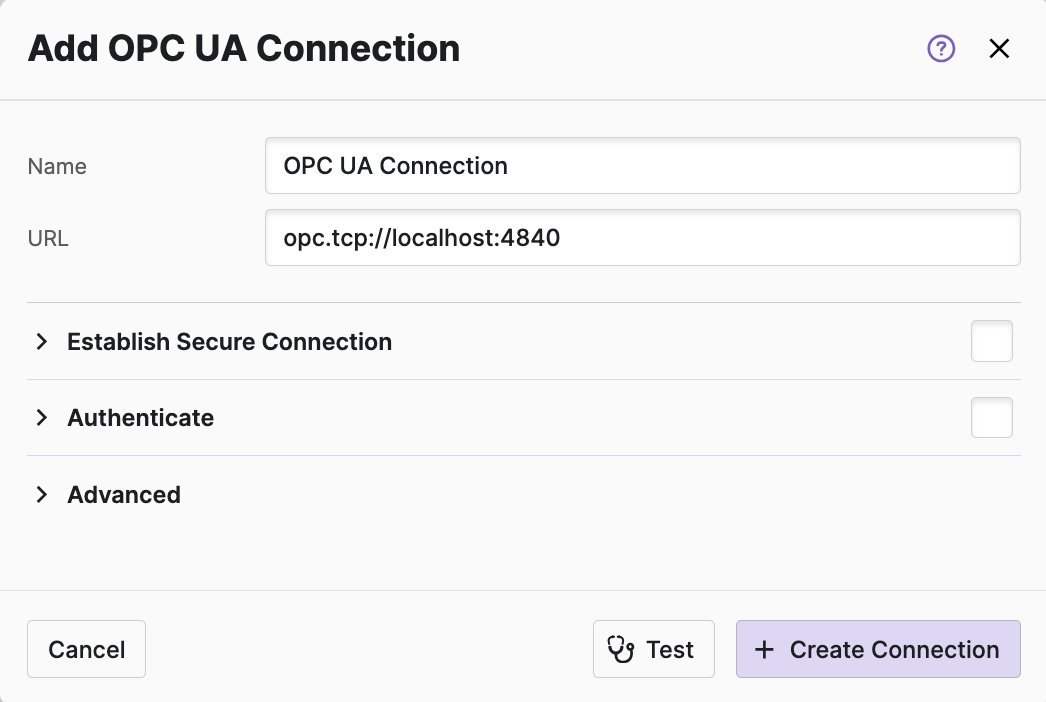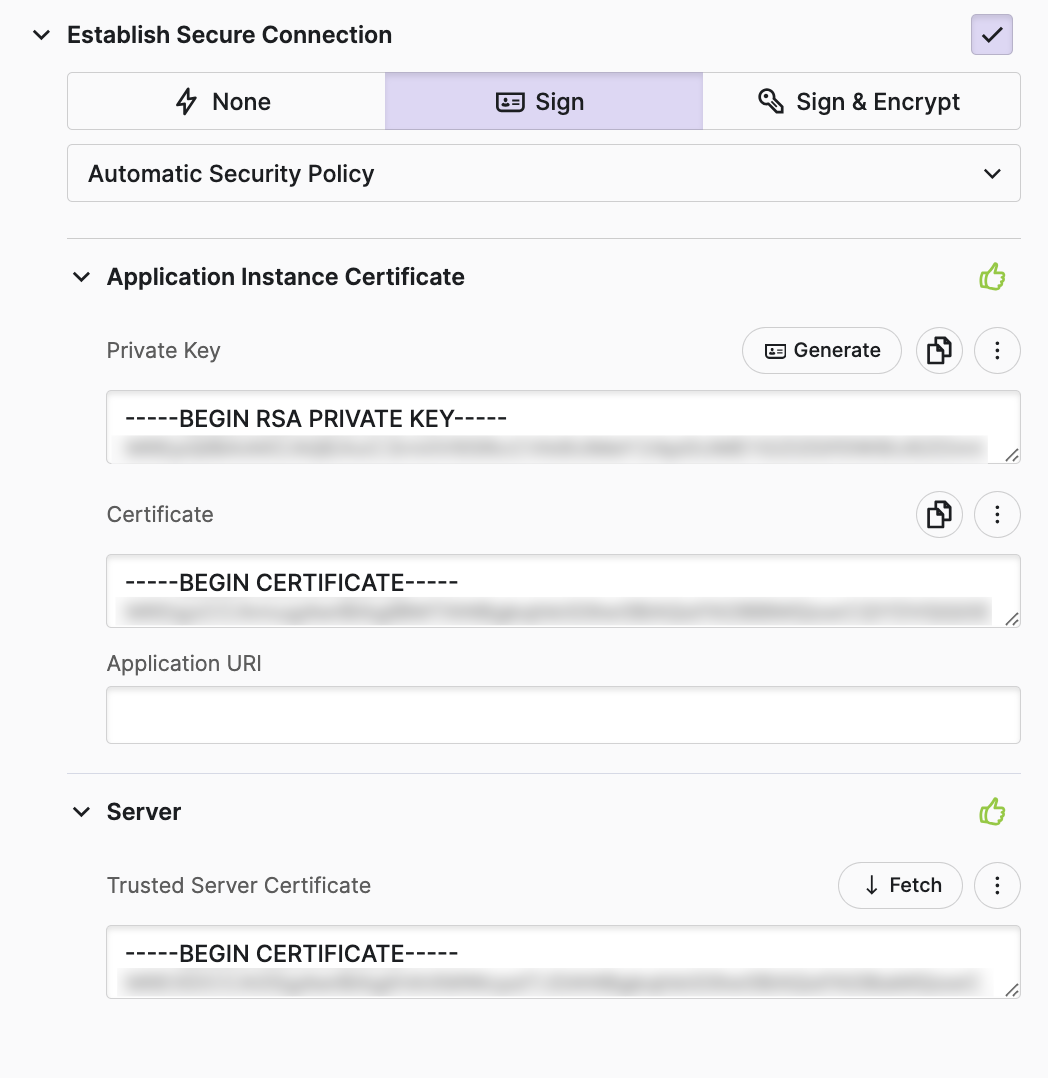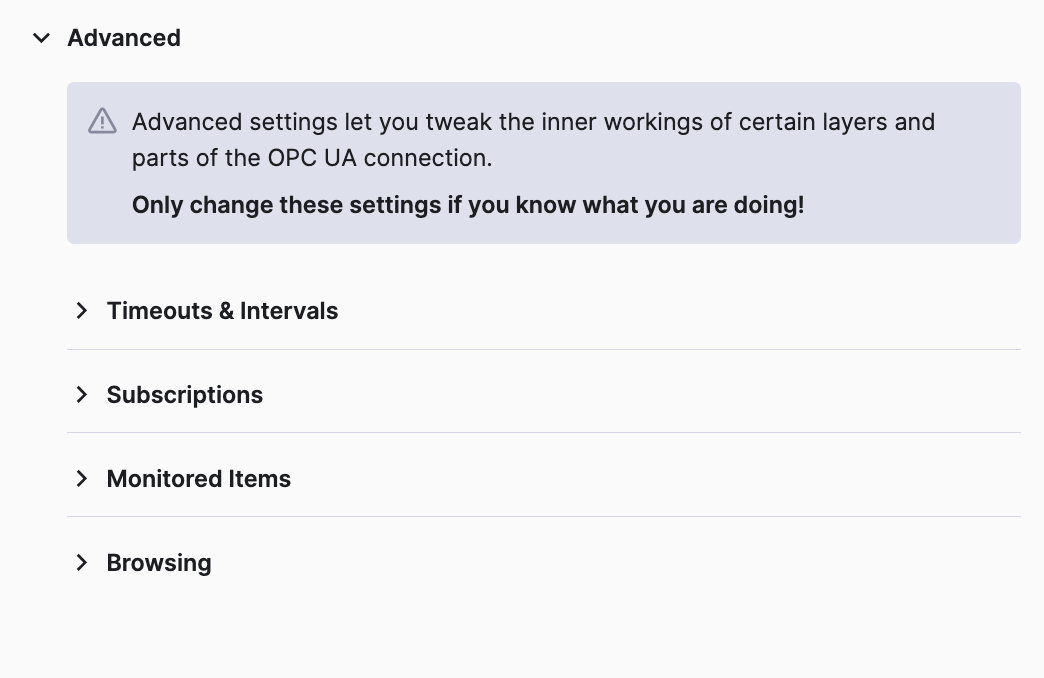OPC UA Connection
The OPC UA Connection lets you connect HELIO to PLCs that comply with the
established
OPC UA
standard.
Test First!
Before creating the actual connection, make sure to
validate that HELIO can connect to your PLC by using the Test
action.
If your test was successful, it's the right time to hit Create Connection.
Basic Options
Name
Will be used by HELIO internally to differentiate between multiple connections.
URL
URL of your OPC-UA endpoint. A valid URL should contain the protocol, hostname, as well as the port.
Establish Secure Connection
OPC-UA has a range of ways to boost connection security. To keep communications safe over less secure networks, you'll need key pairs, certificates, and settings that both the client and server can use to establish trust and security between them.
Friendly Reminder: Strike the Right Balance!
Security should always have top priority in every software related project. Period. But it must also be addressed efficiently and appropriately with the right tools and mindset. For example:
-
If you can ensure a highly secure network connection between client and server using state-of-the-art security mechanisms such as VPNs, or
-
If both the client and the server actually run on the same host and are properly secured from the outside using state-of-the-art security mechanisms and tools such as firewalls
Then you may not need to introduce the complexity of encryption. Dealing with things like certificates always adds potential points of failure such as caused by expired certificates.
Got Questions? Let's Talk!
Contact our Professional Services specialists – we're always ready to listen.
Security Mode
The OPC UA protocol defines several security modes that HELIO allows you to configure.
Mode offering the lowest security:
- Client and server can't tell if messages have been manipulated
- Client and server can't be sure they're talking to a trusted counterpart
- Third parties might be able to read messages sent between client and server
- Client and server can ensure that messages were not manipulated
- Client and server can ensure they are talking with a trusted counterpart
- Third parties can potentially read messages that client and server exchange
Mode offering the highest security:
- Client and server can ensure that messages were not manipulated
- Client and server can ensure they are talking with a trusted counterpart
- Third parties cannot read messages that client and server exchange
Application Instance Certificate
The Application Instance Certificate is the certificate of an
individual Application Instance that has been installed in an
individual host, in your case your HMI project.
HELIO will set up a brand a new Application Instance Certificate for your
project and send it to your server on every future request.
Did You Know?
- Different installations of one software product have different
Application Instance Certificates. - It is sometimes also referred to as the client certificate as it is the counterpart of your server's certificate.
- The default validity period for
Application Instance Certificatesgenerated by HELIO is 10 years.
Key Considerations Regarding Self-Signed Certificates
- Certificate expiration can pose a significant risk. Therefore, when deploying HELIO to production with secure connections enabled, it is essential to implement organizational measures that will allow you to track certificate validity and regenerate and replace expired certificates.
- The default validity period for application instance certificates generated by HELIO is 10 years.
- You can specify the expiration date in days by using the
Generatebutton.
Server
Trusted Server Certificate
This option let's your store the certificate of the server in order to to establish trust between HELIO and the server. Good news is that you don't have to provide it manually because HELIO will automatically try to fetch the server's certificate.
Authenticate
Specify how you want to authenticate against your OPC UA server. The capabilities of your server will determine this setting, so it is important to check them first.
An OPC-UA server can support different types of so-called User Identity Tokens
to implement authentication. Currently, HELIO supports the following types:
| Mode | User Token Type | HMI Users |
|---|---|---|
Disabled |
| Using this setting indicates that your OPC UA Server does not require any credentials. This approach is suitable as long as both HELIO and the OPC UA server are running on the same host and you have implemented the necessary security measures to ensure that the OPC UA server is not accessible from other devices on your network. |
Username & Password |
| Choose this mode if your server requires authentication using a
|
Certificate |
| In this case HELIO will use its |
Advanced
OPC UA connections consist of several layers: a TCP Connection, a SecureChannel, and a Session, and so on. Use these advanced settings to adjust low level inner workings of these layers.
Be Warned, Young HELIOnaut!
Only change and adjust these settings if you know what you are doing.
Timeouts & Intervals
Secure Channel Lifetime
The lifetime of the SecurityToken that gets requested by HELIO when opening a SecureChannel. Specifies when HELIO will renew this token for this channel. If it's not renewed, HELIO's messages will be rejected by the server.
In other words: how long should HELIO wait to try to renew a secure connection?
Requested Session Timeout
Maximum amount of time a session will remain open without activity. If HELIO does not send a request within this interval, the server automatically terminates the session.
Connectivity Check Interval
If the interval is greater than 0, HELIO will run a read request against the server each time the interval is reached.
This can help keep things stable by making sure the PLC doesn't fall asleep or become inactive.
Response Timeout
The maximum time the HELIO OPC UA client will wait for a server response before treating it as an error.
Subscriptions
Think of Subscriptions as a news channels that the server uses to report news to
HELIO. So they are a key part of making your HMI feel responsive. You can then
use this basic subscription to keep track of things, like variables, on the OPC
UA server to see up-to-date values.
Requested Publishing Interval
This interval sets the pace at which HELIO wants the server to send notifications for subscriptions.
- The server can negotiate this value and respond with the actual rate that it can handle.
- The negotiated value will then be the standard sample interval for MonitoredItems assigned to this subscription.
- If the requested value is 0, the server is required to use the fastest supported publishing interval.
Requested Lifetime Count
Controls how long a subscription can exist without communication before the server deletes it. Think of it as a "maximum patience" value.
- It's measured in multiples of the
Requested Publishing Interval.
Requested Maximum Keep Alive Count
This settings controls when the server should send "empty" keep-alive messages when there are no data changes to report.
- If no monitored items have changed for this many times, the server sends an empty message saying "I'm still here".
- It's measured in multiples of the
Requested Publishing Interval.
Practical Example
Imagine you configure the following settings:
|
|
|
|
|
|
This will result in:
- The server checking for changes every second
- If no changes occur for 3 seconds, it will send a keep-alive message
- If the client does not respond for 10 seconds total, the server will delete the subscription
Maximum Notifications per Publish
Controls how many Notifications HELIO will receive in a single publish response.
- Setting this to 0, means there's no limit.
Priority
Controls how the server will handle this subscription under heavy load.
- When multiple Subscriptions are ready to send Notifications and server resources are limited, the server will first service subscriptions with higher priority values.
- For Subscriptions with equal priority, the server will use a round-robin approach to ensure fair distribution of publish requests.
- If your HMI doesn't require special priority handling, just leave this value to 0, which is considered the default priority level in OPC UA.
Monitored Items
OPC UA clients like HELIO define MonitoredItems to subscribe to data and
events. If we continue to apply our analogy that Subscriptions are news
channels, a MonitoredItem would be a specific topic that our HMI is
interested in that is sent through such a channel. The item to be monitored
may be any node within the OPC UA data hierarchy.
Sampling Interval
This interval tells the OPC UA server how often it should check for changes to a particular value. The server tries to perform the monitoring according to your specified schedule, then sends updates to HELIO when changes occur.
One More Time in Simple Words, Please!
Picture This: A Connected Thermometer in Your Home
- When you (the client) connect to the thermometer (the server) via your computer, you can set how often it should check the temperature.
- If you set the
Sampling Intervalto 5 seconds, the thermometer will check the value every 5 seconds. - The server will then run all the checks according to the schedule you've set.
- So it is the server that uses the
Sampling Interval. You can just sit back and wait for updates as they come in.
Now, if you want to know every little temperature detail, you need to check very often. But if you only care about big temperature changes, you can check less often, which saves energy.
Setting the Interval to 0
According to the OPC UA specification, setting the interval to 0 instructs
the server to use its fastest practical rate. Use this setting when maximum
responsiveness is needed.
Imporant Note
However, setting the interval to 0 does not guarantee instantaneous
updates. The actual rate depends on the capabilities of your server and
the underlying data source. The server will determine and return the
fastest interval it can support.
Additionally, please note that HELIO also throttles data updates from its backend to the HMI running inside the browser to ensure the user interface remains responsive. Therefore, even if you select the maximum responsiveness between the OPC UA server and the HELIO backend, the data updates to the actual browser client may still be less frequent.
Use With Caution
Using 0 may significantly increase network traffic and server load. Only
utilize this setting when necessary for your application.
Shorter vs. Longer Intervals
When should you use which? As always, the answer depends on your use case and requirements:
Shorter Intervals
e.g., every 100ms
Pros
- More data points are collected and potentially transmitted
- Will result in near real-time visibility into rapidly changing values
- Less likely to miss brief but important events or spikes
- Better for tracking fast-moving processes or critical systems
Cons
- Network congestion in environments with many subscriptions
- Higher CPU/memory usage on both server and client
- Could impact other network applications
Longer Intervals
e.g., every 10 seconds
Pros
- More efficient use of network resources
- Better scalability (can monitor more points with same bandwidth)
- Less processing burden on server and client
Cons
- Less responsive to changing conditions
- Potentially delayed awareness of critical situations
Recommendations By Use Case
| Use Case | Sampling Interval | Sampling Rate |
|---|---|---|
Standard automation tasks |
|
|
Process monitoring |
|
|
Historical trending |
|
|
Browsing
Browsing allows HELIO to explore and discover the structure of your OPC UA server's address space. Think of it as navigating a file system. You can see what folders, and variables are available. Use the settings in this section to control how HELIO explores your OPC UA server.
Requested Browse Batch Size
Controls how many items HELIO will request from the OPC UA server in a single browse operation. A larger batch size means fewer round trips to the server but may use more memory and take longer to process. A smaller batch size provides more responsive browsing but requires more communication with the server.
Smaller PLCs may require reducing the batch size to ensure they can handle browsing requests while maintaining responsiveness for other operations.
Auto Connecting
Once you establish a connection, HELIO will add it to the runtime permanently. The runtime will automatically connect to this connection during startup and will try to reconnect it if the connection is lost.



